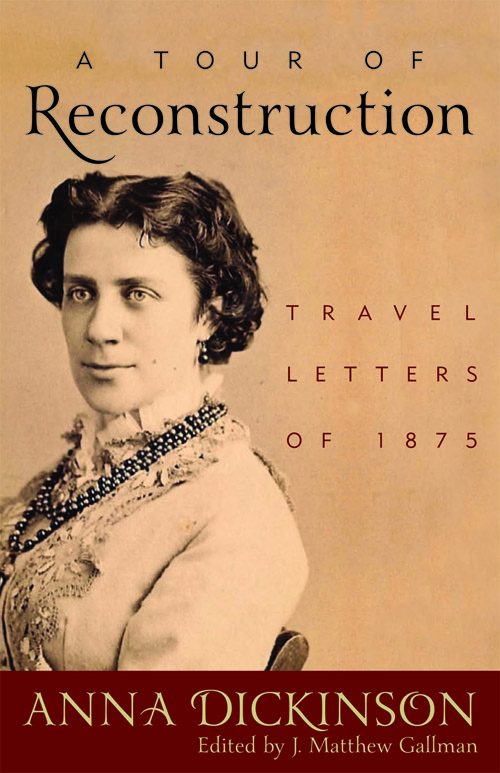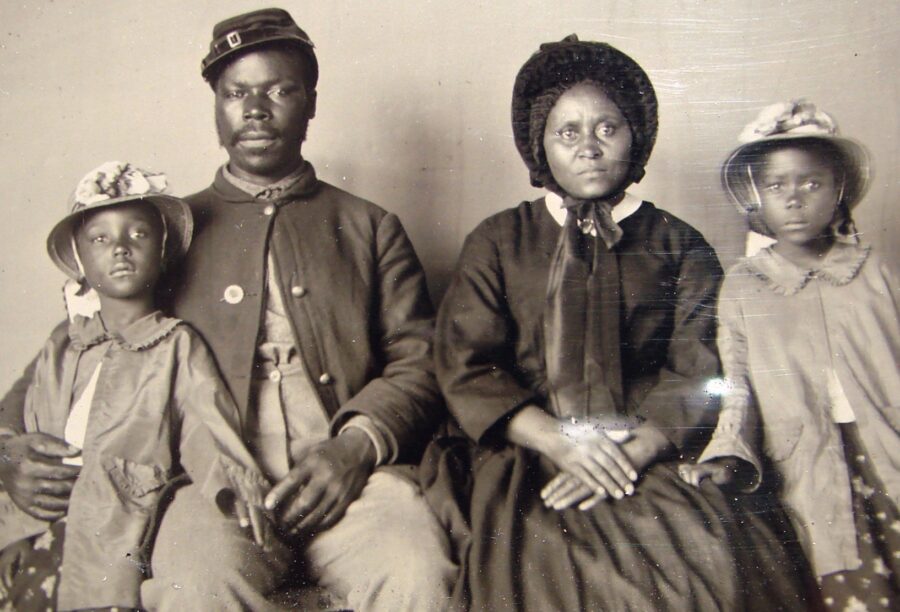A Tour of Reconstruction: Travel Letters of 1875 edited by J. Matthew Gallman. The University Press of Kentucky, 2011. Cloth, ISBN: 0813134242. $35.00.
 Anna Dickinson got right to the point during her travels through the South in 1875. The landscape she encountered in North Carolina was “nothing but dreariness, dirt, poverty, brutishness, & desolation,” and the people “were the most utterly helpless, ignorant, ‘lousy’ degraded, nerveless, limp, slimpsy.” Barely a week into her month-long journey, Dickinson concluded in a letter home to Philadelphia that these sights “depressed me so before night, as to make me actually melancholy” (63-65).
Anna Dickinson got right to the point during her travels through the South in 1875. The landscape she encountered in North Carolina was “nothing but dreariness, dirt, poverty, brutishness, & desolation,” and the people “were the most utterly helpless, ignorant, ‘lousy’ degraded, nerveless, limp, slimpsy.” Barely a week into her month-long journey, Dickinson concluded in a letter home to Philadelphia that these sights “depressed me so before night, as to make me actually melancholy” (63-65).
Dickinson saw no romance in the postwar South. It was not a region of causes lost or of honorable veterans defeated in battle by their more powerful brothers. It was not a place where the past was receding in the interest of sectional reconciliation, or where the chances of a “new” South rising from the ashes of war looked at all promising. All such images that white southerners were peddling to their northern neighbors at the time—and which some obliging northern tourists and novelists worked into their writing—failed to register with Dickinson. The result, as evidenced in J. Matthew Gallman’s expertly edited collection of her letters, is an extended commentary on the South at Reconstruction’s end that is blunt, shrewd, and occasionally surprising.
Dickinson’s perspective may sound familiar to those already acquainted with her unconventional life story. (And anyone interested in learning more should consult Gallman’s America’s Joan of Arc: The Life of Anna Elizabeth Dickinson [Oxford University Press, 2006]). This daughter of abolitionists made a name for herself at the early age of 14, when she had a letter published in William Lloyd Garrison’s antislavery newspaper, the Liberator, and then launched a public speaking career that turned her into what Gallman calls “a bona fide celebrity” by the age of 21 (3). During the Civil War she became an outspoken voice of radical Republicanism, pushing Abraham Lincoln to be more decisive on slavery, and in the postwar period channeled her fame into a career as a lyceum speaker on topics ranging from women’s rights to compulsory education to penitentiary reform. It took her ten years after the war’s end to extend her speaking tour into the South, but in 1875, two years after a national economic crisis made it more difficult to obtain speaking engagements elsewhere, Dickinson boarded a train with her agent, O.W. Bernard, and headed first to the former Confederate capital in Richmond, Virginia.
A helpful map opens this volume and traces Dickinson’s journey through Virginia, North Carolina, South Carolina, Georgia, and Tennessee that lasted the entire month of April. The letters that follow likewise move chronologically and geographically, documenting Dickinson’s travels to each of the region’s larger cities, where she stopped not only for speaking engagements, but for tours of Civil War sites such as Andersonville, and for visits with such notables as Richmond’s Elizabeth Van Lew, the Union spy. Along the way she drafted four letters to her mother—although really they are more like extended essays than traditional letters, since each is quite lengthy and utterly devoid of the personal information one might expect in correspondence between a daughter and mother.
Instead Dickinson focused her lens broadly and documented a wide-ranging set of observations about the state of the South’s economy and politics. She was particularly attuned to the fluid political situation, as all the states she visited, with the exception of South Carolina, had recently experienced a Democratic resurgence—or “redemption”—that ended the rule of her fellow Republicans. She was perceptive enough not to overgeneralize about what this meant across the South, however, and took note of state-to-state differences instead. Virginia, for example, earned her esteem: for although Democrats had ruled longer there than elsewhere, they had managed to establish a public education system benefiting blacks and whites alike. The state’s example, in fact, led Dickinson to conclude that the South’s affairs were perhaps best left in the hands of states run by white southerners (albeit those committed to some interracial cooperation). That’s quite an admission for a radical Republican.
And here is where this collection is perhaps most illuminating. Dickinson’s letters are not just about the South but about Dickinson herself—or more specifically, and about what happened to radical advocates of abolition like her once the war and emancipation receded into the distant past. She may have once been a passionate opponent of slavery, but, her words remind us, that did not mean her general outlook on race was clear-cut or necessarily progressive. She supported education and voting rights for freedpeople, to be sure, but she was also quick to condescend to African Americans in South Carolina, whose “dignity & air of command” she found “curious” (and in contrast to the “darkies” of Georgia) (99), or to chide fellow northerners who went South to teach freedpeople and used the titles “Mr.” and “Miss” with their students rather than first names. This practice was “absurd,” in Dickinson’s view, since “[t]here is enough native tendency to pomposity & ‘airs’ & folly amongst these people without fostering such a growth” (80). With statements like these from one of the radicals, it may be no wonder that Reconstruction would come to an end.
Gallman has made an important contribution by pulling Dickinson’s letters out of the archives—deciphering her difficult handwriting in the process—and making them more widely accessible. Her writing about Reconstruction can now join the ranks of other published travel writers of the period, such as Sidney Andrews and J.T. Trowbridge, while inserting a powerful female voice among them. Her experiences in the South, indeed, were not the same as the male travelers’, from her bitter encounters with white southern women—“the women hate me & wont come to hear me” (49)—to the nine former Confederate generals who showed up at her lecture in Savannah and tried to overwhelm her with their “magnanimity & condescension towards a Northern woman” (115).
Keep a bookmark handy, though: Gallman’s very useful annotations explaining portions of Dickinson’s writing are relegated to the back of the book, rather than at the bottom of the page where they might have been more useful. It would also have helped to see the sketches of southern scenes that Dickinson incorporated into her letters but are omitted from this volume. These are minor issues, however. Dickinson’s perspective is unique and eye-opening—and well deserving of attention from anyone wanting to know more about how northerners and southerners tried to pick up the pieces and relate to one another a decade after the Civil War.
Amy Murrell Taylor is an Associate Professor of History at the University of Albany (SUNY) and the author of The Divided Family in Civil War America.
